




He pou atua, he pou whenua, he pou tangata.
Ko Waitematā te moana
Ko Waikōkota te whenua.
Ko Te Pou Whakamaharatanga mō Māui Tikitiki a Tāranga te tohu o te kaha, o te kōrero, o te whakapapa o tēnei wāhi, o tēnei whare.
Nau mai e te tī, e te tā ki te whare kōrero, ki te whare whakaari o ASB ki te tahatika o te moana.
Mauri tau, mauri ora!
Pouwhakamaumāharatanga mō Māui-Tikitiki-a-Tāranga
The Memorial Post of Māui the Topknot of Tāranga
Robert Jahnke ONZM (Ngāi Taharoa, Te Whānau a Iritekura, Te Whānau a Rākairo o Ngāti Porou) 2016
Laminated tōtara and Corten steel
Proudly commissioned by Auckland Theatre Company for ASB Waterfront Theatre


The symbols of support, of strength and of guardianship stand fast and proud.
The waters of Waitematā ebb and flow against the shores here at Waikōkota, the land upon which we stand.
The pou of remembrance to Māui Tikitiki a Tāranga stands tall as a beacon of courage, of stories passed down and of the history that connects us all to this place and to this space.
We welcome you all from near and far to this house of stories, to the ASB Waterfront Theatre.
Mauri tau, mauri ora!
AGARAM PRODUCTIONS, AUCKLAND THEATRE COMPANY AND TE AHUREI TOI O TĀMAKI AUCKLAND ARTS FESTIVAL PRESENT

4 – 23 MARCH 2025

a mixtape for maladies written by Ahilan Karunaharan, directed by Jane Yonge, is the first production in Auckland Theatre Company’s 2025 season. It had its first public staged reading at OPEN STAGE as part of Te Ahurei Toi o Tāmaki Auckland Arts Festival, 2023, in partnership with Auckland Theatre Company. This production began previews on Tuesday 4 March and premieres on Friday 7 March at ASB Waterfront Theatre, Auckland.
a mixtape for maladies is a collaboration between Agaram Productions, Auckland Theatre Company and Te Ahurei Toi o Tāmaki Auckland Arts Festival.
The production is 1 hour, 30 minutes long without an interval. It includes themes of war and trauma and is recommended for those aged 12 years and older. Please switch off all mobile phones and noise-emitting devices.
PRINCIPAL FUNDERS:
CORE FUNDER:
Ambika G.K.R —
Sangeetha (present)
Ravikanth Gurunathan —
Vishwanathan
Ahilan Karunaharan — Rajan
Shaan Kesha — Deepan
Tiahli Martyn — Subbalaxmi
Gemma-Jayde Naidoo —
Sangeetha (past)
Bala Murali Shingade —
Anton/Suthan
Ben Fernandez
Seyorn Arunagirinathan
Playwright — Ahilan Karunaharan
Direction Jane Yonge
Production Design —
Filament Eleven 11 - Rachel Marlow
& Bradley Gledhill
Costume Design —
Padma Akula
Music Direction — Karnan Saba
Sound Design — Te Aihe Butler
Choreography — Ahalya Sathiyaselvan
Performance Dramaturg —
Leo Gene Peters
Vocal Coach – Indian classical —
Balamohan Shingade
Vocal Coach – technique —
Cherie Moore
Props Design — Ella Madsen Brough
Engine Room Assistant Director — Nī Dekkers-Reihana

AGARAM PRODUCTIONS
Co-Producer — Ahilan Karunaharan
Community & Cultural Advisor — Mervin Constantine
Community Liaison — Sananda Chatterjee
PRODUCTION
Stage Manager — Chiara Niccolini
Deputy Stage Managers —
Michael Clark &
Eliza Josephson-Rutter
Assistant Stage Manager —
Sofia Miernik
Head of Staging — Molloy
Technical Manager —
Ella Madsen Brough
Technical Operator — Max Koenig
Sound Co-ordinator —
Nathanael Bristow
Sound Operator — Joel Orme
Microphone Technicians — Paul Jeffery, Louis McKendry & Tim Jansen
Fly Technician — T.J. Haunui
Seamstress — Bhawani Sivakumar & Lauren Millar
Costume Assistant — Adhirai
Teaching Artists — Lerato Islam & Sean Dioneda Rivera
Consultant Psychotherapist — Rachel Davies
Production Photography — Andi Crown
Education Pack Writers —
Lerato Islam, Sean Dioneda Rivera & Anna Richardson


Welcome to this collaboration between Agaram Productions, Auckland Theatre Company and Te Ahurei Toi o Tāmaki Auckland Arts Festival.
The three producers who have come together to create a mixtape for maladies have a long and fruitful history of working in collaboration in many guises. The universe brought the three of us together at this time to present a work that connects the place we are in now with an earlier period in Sri Lanka as musical memories guide a mother and son to new understandings and a deeper closeness.
Auckland Theatre Company and Te Ahurei Toi o Tāmaki Auckland Arts Festival salute our collaborator, the treasured playwright Ahilan Karunaharan. a mixtape for maladies represents a landmark achievement by Ahilan, who has created an epic trilogy of plays that debuted at the Auckland Arts Festival in 2018 with TEA, continued with The Mourning After in 2021 and now reaches its climatic conclusion.
This trilogy has been exploring memory. The plays cross oceans of time as worlds since gone speak with us now and then throw forward into what the future might hold. The plays are shot through with universal human experiences, the quest for love, the conflicts and resolutions of family, and the meaning of home.
At the helm of this production is director Jane Yonge who returns to the ASB Waterfront Theatre after her phenomenal success with Scenes from a Yellow Peril in 2022. Jane has led the making of this work with such a generous heart and incisive intellect. Her cast, creative team and production team have worked tirelessly, handcrafting this beautiful new, elegiac work. We offer our thanks and praise to the company of a mixtape for maladies for the aroha with which they have approached each other and this play. Together, we welcome you to the world premiere of a mixtape of maladies.
Ahilan Karunaharan Agaram Productions
Bernie Haldane
Kaitohu ToiArtistic Director
Te Ahurei Toi o Tāmaki
Auckland Arts Festival
Jonathan Bielski
Artistic Director & CEO
Auckland Theatre Company
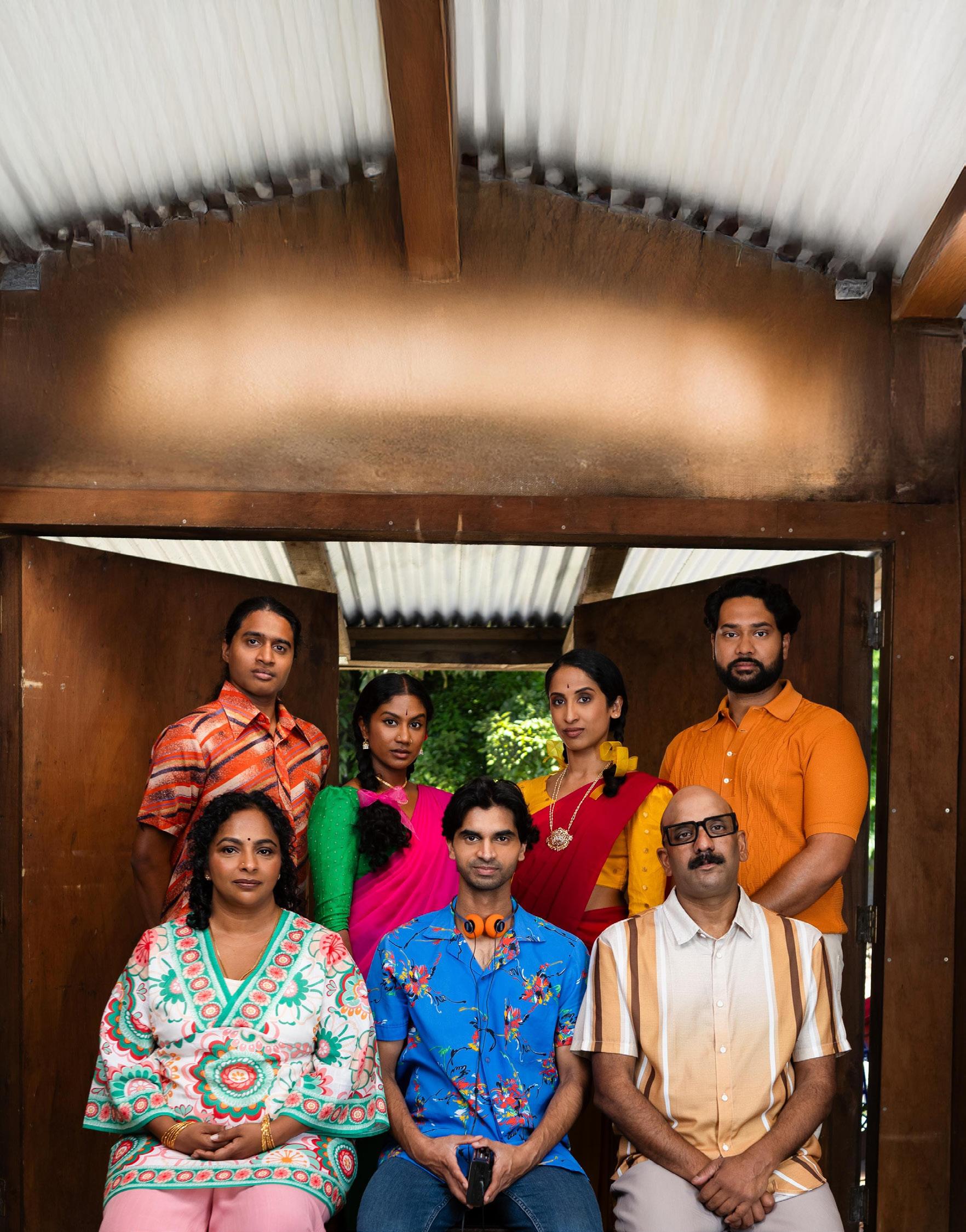
Agaram Productions is a boutique multidisciplinary production house, specialising in developing and creating works from New Zealand’s South Asian and diaspora voices. Founded by Ahilan Karunaharan, the multi-awardwinning production company has been championing alternative narratives and otherness since 2013.
Over the last 11 years, Agaram has presented more than 14 world premieres of South Asian works, has made space for more than 150 creatives and performers to be heard and seen, has developed and workshopped more than 50 new voices and works, and continues to be a pioneering and trailblazing independent development company.
a mixtape for maladies is the final instalment of my trilogy of theatrical excavations centred around home, memory and nostalgia.
At the time of writing the first instalment, it had almost been 25 years since we left Sri Lanka. The act of writing was one of the only ways for me to return, document and archive our past.
It is impossible to fit a nation’s history into a single narrative and just like a mixtape, I have come to understand that this is a compilation of multiple stories and truths.
This work is a collation of various stories. Mine, my mothers, my uncles and aunties, my cousins, my extended relatives, our family friends, our neighbours and my community.
I thank the cast and creatives for their contributions in filling the gaps and making this script sing in a way that we all imagine. My hope is that perhaps one day in the future we can look back on this work, and on our nation’s past and hear a new mixtape that tells a whole new story.

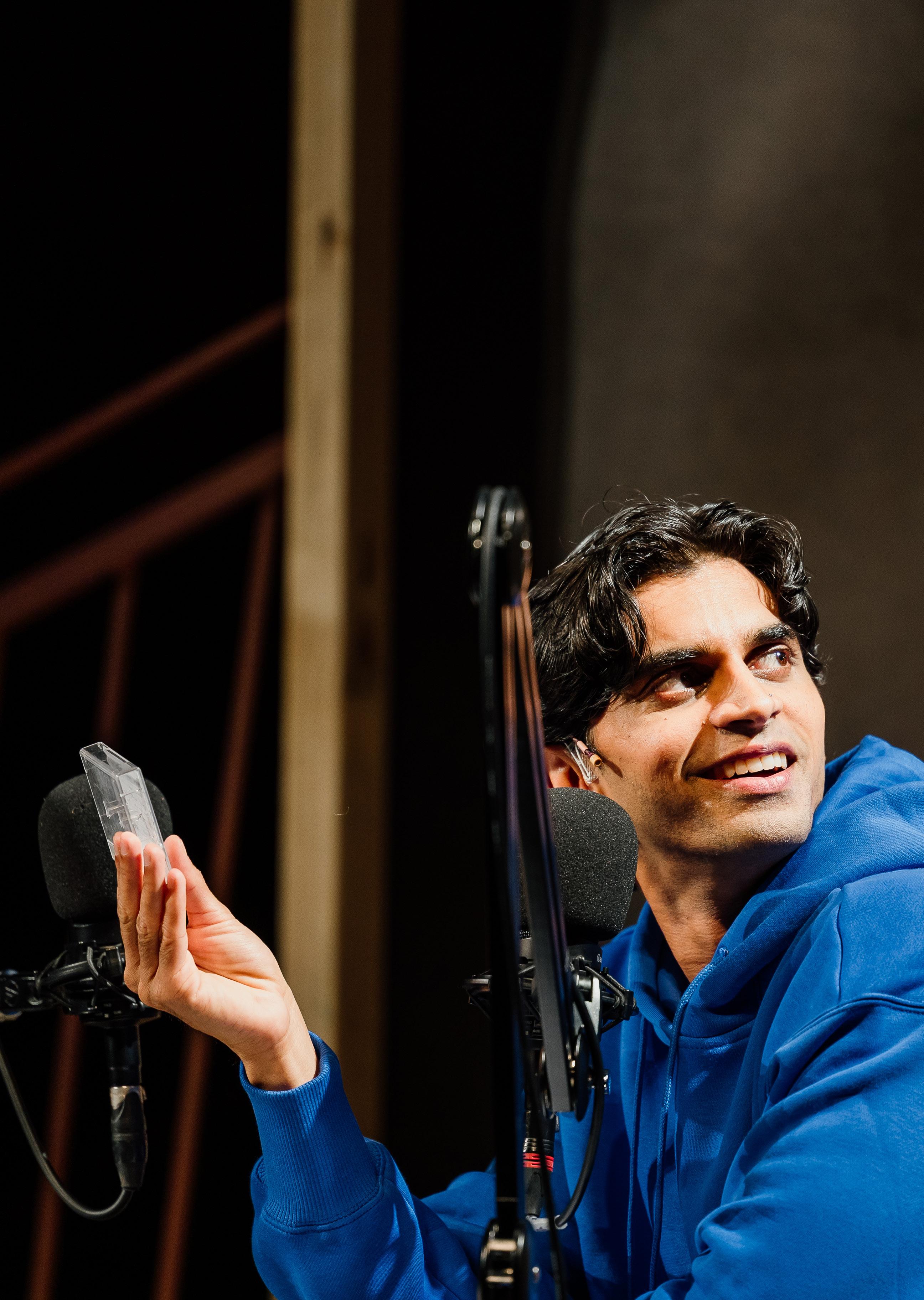

In 2022, when Ahilan asked me to direct his play, a mixtape for maladies, I jumped at the chance to work with my dear friend and talented collaborator. But what I thought was a small, cabaret-style show, turned out to be the final work in Ahilan’s epic trilogy of plays exploring home, belonging, grief and – of course – Sri Lanka. I am especially honoured to be directing mixtape, because this is the only play in the trilogy that Ahilan has not directed himself.
I love this play. It’s so honest, real, painful, romantic and nostalgic – so darkly and deliciously funny. It’s also not my story. It’s Ahilan’s story and it’s a deeply Sri Lankan story. But it is also a story that will be resonant for many tauiwi in Aotearoa, like me, who share family histories across generations of fleeing oppression, war and military occupation.
Questions of disconnection, identityloss and language-loss tether me to mixtape. However, just as it is for Sangeetha and Deepan, Aotearoa is safety and it is home, and I am grateful to be here and for my children to be here. Toitū Te Tiriti!
This show could not have happened without its incredible cast, crew, musicians and creatives. A massive shout-out to Filament Eleven 11, Padma, Karnan, Te Aihe, Nī, Ahalya, Sananda, Kathryn, Chiara, Michael, Balamohan, Cherie and Leo. Thank you to Mervin Uncle for your wisdom and experience. Massive thanks to Auckland Theatre Company, Te Ahurei Toi o Tāmaki Auckland Arts Festival and Agaram Productions for hosting, producing and supporting this work. Finally, thank you Ahilan –for introducing me to your world, your heart and the music.

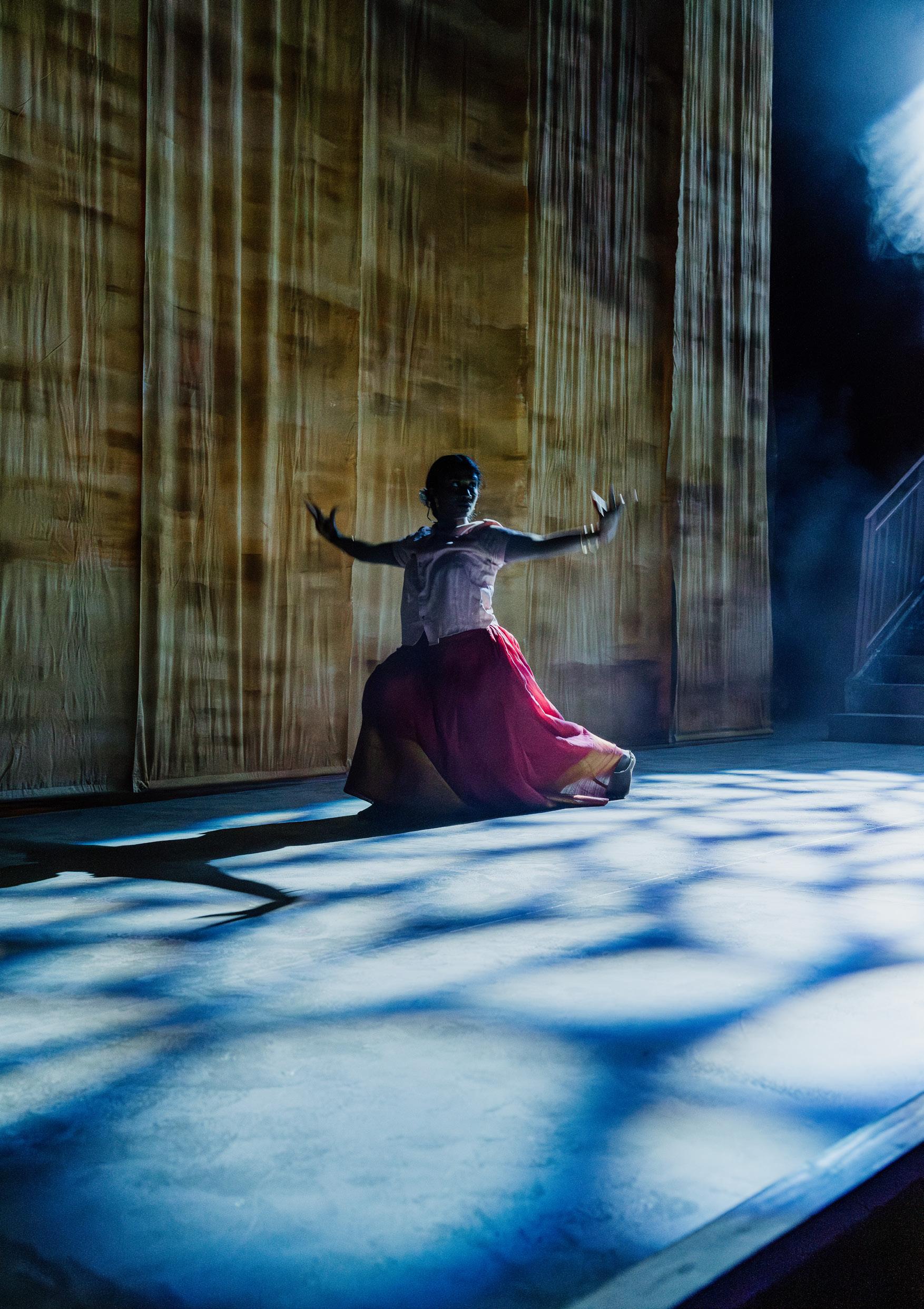
In Tamil there is a saying "maranathaivida kodiyathu marakkapaduvathu," which loosely translates as "the fate of being forgotten is worse than death."
As artists of the South Asian diaspora, our actors have lent their voices as allies to this kaupapa so that these vital stories can still be told on our stages.
The Tamil spoken in Sri Lanka varies across the regions, and for the purposes of accessible storytelling, we have employed a broad South Asian accent for this production.
Similarly, the songs featured in this work were originally composed and sung by legendary stalwarts of the music industry, and as a company, we have reimagined these songs and music.
This is a work about a past that no longer exists. We have had to imagine and recreate it so that it is not forgotten in the future. As children of the diaspora, we are at various stages of our journey of reconnecting with our mother tongues.
It is our hope that one day this work will be performed by an all Sri Lankan cast.
Ahilan Karunaharan

"True healing can only come with the cleansing of the wound - with truth. a mixtape for maladies is an ongoing artistic excavation of the multiple truths of my motherland’s past. Many of the stories of my Tamil community remain untold and there is very little in the way of public acknowledgement of our nation’s war history. This work is a small attempt to fill that silence."
– Ahilan Karunaharan
from the introduction to the OPEN STAGE reading, 2023

Set in both present-day Aotearoa and past Sri Lanka, the narrative follows Deepan, a young man who discovers an old mixtape in his family home. As he questions his mother Sangeetha and listens to the mixtape, he delves into the intertwined lives of Sangeetha’s family, including her father Rajan, her siblings Subbalaxmi and Vishwanathan, and her love interest Anton.
As Deepan uncovers the truths hidden in the mixtape, he navigates through various settings, from


a makeshift podcast studio in Aotearoa to a temple fair and a bunker in Sri Lanka. The play explores their experiences during significant historical events, such as the Point Pedro Massacre and the rise of the Tamil Tigers, highlighting the impact of war, displacement, and cultural identity.
a mixtape for maladies is a celebration of music’s power to heal and connect, and the enduring impact of the past on the present.

"a mixtape for maladies is part memory play, part mystery, part musical. Staging of this work can be as intimate or as epic as your imagination (and budget) allows you to dream. This is a work of people imagining and recreating a past that no longer exists."
"This text is a collation of various stories. Mine, my mother’s, my uncles and aunties, my cousins, my extended relatives, my family friends, my neighbours, my community."
"It’s impossible to fit my nation’s history into a single narrative. And whilst in this work Deepan’s quest to unearth the ’the truth’ of his mother’s past and through it what happened in Sri Lanka via the mixtape, I have come to understand that this is a compilation of multiple truths."
"From a makeshift podcast studio, a garage in Aotearoa, a temple fair, a cinema hall, a music store, an open field, a bedroom, a drawing room, a bunker, the music videos of the yesteryear’s celluloid this mixtape traverses across time and space.
"All I ask is that we collectively unpack this cacophony with me."
Sri Lanka is an Island nation off the coast of India. Sri Lanka’s population is split between two major ethnic groups: The Hindu Tamils and the Buddhist Sinhalese. These two groups have their own distinct languages, culture and practices.
In 1815, the British colonised Sri Lanka. At that time, the population was roughly 3 million Sinhalese and 300,000 Tamil people. During their rule, the British brought over nearly a million Tamils from India to Sri Lanka, to work in the coffee, tea and rubber industry.
Tensions between the Sinhalese and Tamil populations started to appear during British Colonial Rule. The British seemed to give Tamils preferential treatment, by favouring them for Civil Service jobs, and building good infrastructure, such as schools, in the North of Sri Lanka where most Tamils lived. This created tension between the two ethnics groups, and the Sinhalese population, who were still the majority, started to resent the Tamils.
When Sri Lanka gained independence in 1948, a Sinhalese government took power. They created a lot of laws that discriminated against Tamils, such as declaring Sinhalese as the only official language of Sri Lanka and stopping Tamils from acquiring Sri Lankan citizenship. Time passed and animosity between the two groups kept escalating.
The Sri Lankan Civil War started on the 23rd of July 1983. The Tamil Tigers, a separatists militant group who fought for the creation of an independent state for the Tamil people, led an armed rebellion against the government. This triggered a 26-year Civil War between the Tamil Tigers and the Sri Lankan government. The Sri Lankan Military eventually defeated the Tamil Tigers in May 2009, ending the Civil War.
The Tamil population of Sri Lanka suffered extreme hardship during the war, as well as constant fear, violence and displacement. Although the war is in the past, Sri Lankan Tamils, and the diaspora, still carry the scars, memories and traumas of this devastating era.
Analysis of the historical context of a mixtape for maladies
Understanding the historical context that Karunaharan drew from when writing a mixtape for maladies and how it was reflected in the performance, will enrich how you discuss the show as a class and how you write about it for assessment purposes.
As a class read through the historical context information on page 15. As a class, write up the ideas that you think you need to research further to gain a better understanding on the whiteboard. Split into smaller groups and choose one of the ideas or historical moments you have identified as a class. Complete the following:
• Research the idea or historical moment
• Make notes on a shared document, ensuring that you take note of references
• Collate visual material that is relevant and insert it into your document or save in a shared folder
Bring your research back to the class and then create a large visual timeline that you can blue tack to the wall, or you could use a digital programme such as Canva. Once you have put together the historical timeline, add in a moment from the performance that connect to the historical moments or ideas you
have researched, these could be represented through:
• A sketch of the moment onstage, with detailed annotations
• A quote from a character
• A brief explanation of the moment If you are creating a digital timeline, you could add voice notes describing the moment.
When you are revising for your live performance exam; thinking about the wider context of the play being staged, whether that is historical, political, social and/or geographical. a mixtape for maladies draws from a rich wider context, placing the action of the play in Sri Lanka and Aotearoa, in the past and in the present. While the exam is not about the way the play is written, when you explain and discuss moments depicted on stage, unpacking how those moments draw from the way that Ahilan Karunaharan has structured the play, the themes he identifies, and what inspired the story will enrich your answer. You will also want to unpack what you think Jane Yonge intended to communicate through her choices
and how this connected to what Karunaharan intended. You will want to think about how the play explores historical moments, cultural identity, music’s power to heal and the enduring impact of the past on the present.
For these activities reference the Director and Playwright’s notes on pages 8 - 14.
Pre-reading and listening:
• Read through both Jane Yonge and Ahilan Karunaharan directors and playwright’s notes and the note about Agaram Productions:
• Highlight ideas that interest you
• Circle quotes you think would enrich an idea in your portfolio or in an answer in an exam
• Underline and annotate ideas that link to a specific moment in the performance.
• If you recorded the post show forum, find excerpts where Yonge or Karunaharan answered questions:
• Write down ideas that interest you
• Record quotes you think would enrich an answer in your portfolio or exam
• Record moments in the forum that surprised you or provided more context for something you saw on stage.
ideas:
Using the ideas you have recorded above, create a comprehensive mind map that explores how the ideas outlined by Yonge and Karunaharan were realised on the stage. Follow these instructions to set up a mind map:
• Choose a central idea you or your group find compelling, placing it in the centre of a large piece of craft paper or on a document on your device
• Add main branches and subbranches; for example, how technology was used to represent this idea, how an actor embodied the idea, a key moment in the performance that brought the idea to life, what you have thought about since the performance
• Connect the ideas through colour coding
• Add visuals, such as sketches, references images
• Incorporate quotes from the performance, and the information in this pack
Revision essay:
For homework write a short essay; approximately 200 words, responding to the following prompt. Share this with a peer or your teacher to review.
Respond to Yonge’s statement that a mixtape for maladies is “a story
that will be resonant for many tauiwi in Aotearoa, like me, who share family histories across generations of fleeing oppression, war and military oppression.”
What do you think Yonge means by this statement? How is this reflected in the way she has directed the play? How do you connect to this personally - what does it make you think about and how does it make you feel?
• How did the way the play was staged differentiate between past and present, Sri Lanka and Aotearoa?
• How did the way the play was structured highlight ideas, themes and historical events?
• Discuss how music was incorporated into the structure of the play, and why it was important to the story being told?
Exploring the structure of a mixtape for maladies a mixtape for maladies looks at the “enduring impact of the past on the present” through the way Karunaharan structured the play. As a class discuss the following prompts and record your ideas, either through brainstorms, notes or voice recordings you can reference later. You could split into groups and explore one prompt each:
• Discuss how production choices differentiated between the characters of the past and the characters of the present
• How were historical events woven through the play and why was this important to the story being told?
Extension activity - Write a short response or record a voice reflection responding to the following:
Why do you think Ahilan Karunaharan structured the play the way he has? How did the structure of the play impact how you personally responded to the story being told?
From Ahilan’s introduction to the script, and his notes to actors;
Where possible allow the use of Jaffna Tamil in the text. Srilankan Tamilians are notorious for speaking at breakneck speed, allowing the text to ebb and flow and earn those moments of silence, because only in silence can you find your inner truth.
– Ahilan Karunaharan.
Tamil Glossary
— Vanakkam- Hello
— Eppati irukkirirka? – How are you?
— Amma – mother (or older woman)
— Appa – father
— Akka – elder sister
— Thangai – younger sister
— Anna – elder brother
— Thambi – younger brother
— Ma – term of endearment
— Enna? – What?
— Dei! – Oi!
— Ithuvum kadanthu pogum – Life must go on
— Poitu vaaren – Goodbye
Fun fact: Poitu vaaren literally means: “I shall go now, but I will come back”. Tamil people avoid using the word for "Goodbye", as they believe this means the person will never return. Try and listen to when Sangheeta says Poitu Vaaren in the show- who answers her and who doesn’t?


Design
Three worlds linking the past to now:
Rachel and Brad Marlow have crafted 3 distinct worlds: a mixtape for maladies takes place inside of “so we’ve got the podcast world of the present…and then we’ve got the band world with a big, gorgeous gold curtain… then we’ve got the past – with this calico that can be lit and can really heighten a feeling and become quite romantic.”
There’s a large focus on functionality with the set design, on making sure design doesn’t impede on the action and flow of the show: “So we’re trying to set up these little spaces
that can be set up behind the drama of and then dramatically be revealed to take us to a new place. Upstage structure which creates rooms, which can become houses, a cinema and then be opened up completely for the engagement party giving the actors full reign to move all over the stage. The inspirations that colour this world are rich in references, including photos from Ahi – the writer’s most recent trip to Sri Lanka, music videos from the Sri Lankan scene and musicals- including Oklahoma – you can see this in the architecture of the set and in the spectacle of the musical world.



Research Image Set Render

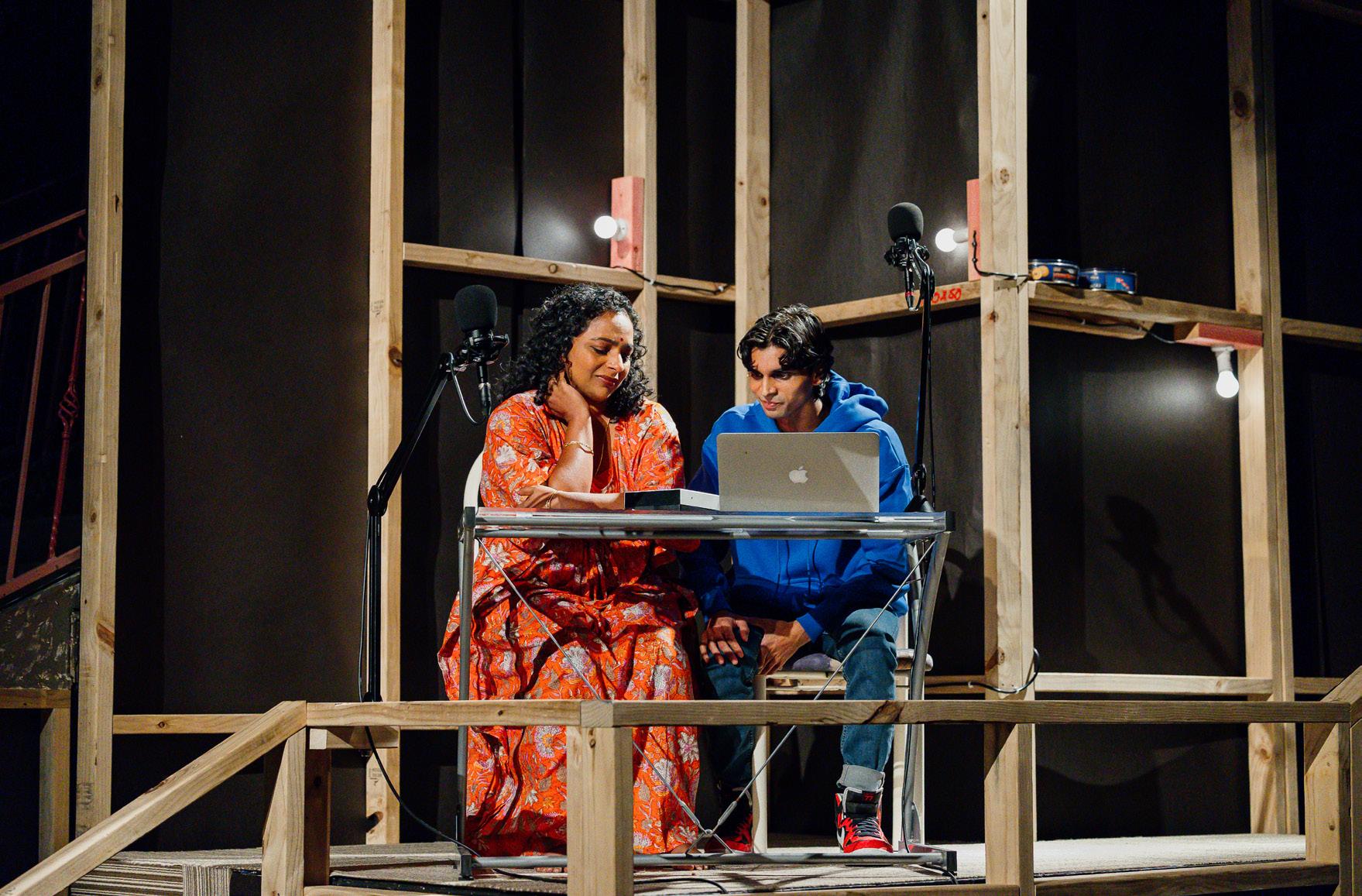
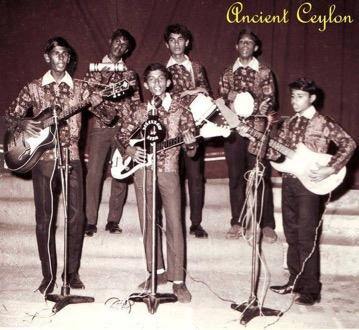
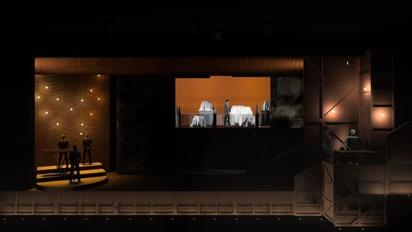


Research Image
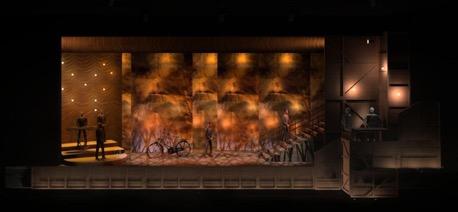
Set Render


Set Plans
The lighting design weaves together three distinct worlds within the production, using light to help audiences navigate between location and time periods.
The past is bathed in warm, rose-tinted hues, creating a sense of nostalgia and memory. Moments of danger are emphasised through dramatic lighting shifts. The design works in close harmony with the sound design, with lighting cues often motivated by and responding to the audio landscape.
Practical lights are strategically placed throughout all three worlds, grounding each setting in reality while maintaining their unique characteristics.
During the show’s musical spectacular moments, these separate worlds dramatically merge through lighting, creating a unified visual experience that breaks down the barriers between the different realities.



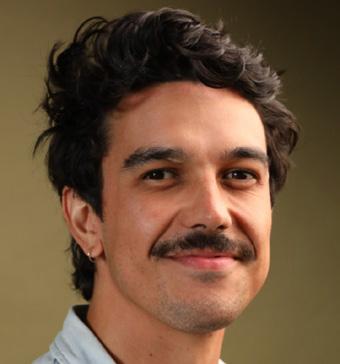
TE AIHE BUTLER
Ngāti Porou, Te Whānau-a-Apanui
Sound Design
"First and foremost, the sound design for a mixtape for maladies exists to support the music. The soundtrack is incredible and is arguably the most important part of the whole thing. And if the sound design does its job properly, it will help us transition in and out of musical numbers that can force between time periods from diegetic sound to non-diegetic sound."
– Te Aihe Butler – Sound Designer
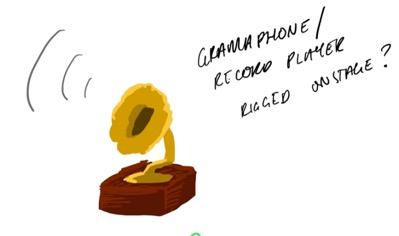
There are two sound design languages, the first being the mundane and the second being the abstract:
These are the everyday sounds that help create the world of the play. Sound designers use these fundamental elements like gunshots, vinyl record scratches, market crowd noise, and street ambiance to establish location, time period, and atmosphere. These sounds act as audio clues for the audience, helping to ground the story in reality, create a sense of place, and make the world feel authentic. They support the narrative by giving audiences the information they need to understand where and when the story is taking place.
Abstract is the other design language which is a bit more wibbly wobbly, it turns and textures and sound designy things that don’t necessarily exist in the literal world of the play. They kind of support the emotional reading for the audience as they watch. So this is some base tones, it’s kind of whooshy transitional noises And it’s the stuff that’s kind of like connective tissue between scenes. They help transitions feel fluid and seamless and help us crank out the tension where we need to.
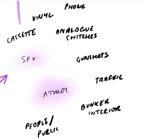


PADMA AKULA Costume Design
In designing the costumes for a mixtape for maladies, set in Jaffna, I made sure to blend fashion trends with Jaffna Tamil culture, history, and the influence of Tamil cinema from Tamil Nadu, India. The costumes were crafted to evoke nostalgia while reflecting the broader historical shifts of each period. Since many of the songs in the play are drawn from Tamil cinema, I took creative liberty in incorporating elements of Tamil cinema fashion to compliment the music and the story.
The most challenging aspect of designing the costumes for a mixtape for maladies was striking the balance between authenticity and the practical demands of the production, particularly managing the ’quick changes’ for
the characters across scenes that span different phases and ages. Each costume needed to maintain cultural and historical accuracy while also accommodating the rapid transitions necessary for the actors.
Collaboration with the playwright and director was crucial, and trust played a significant role in the process. Having designed many, if not all, of Ahilan’s (the playwright) productions, a strong foundation of trust had already been built over the years. Though I’ve known Director Jane for years, this was our first project together, so we had many conversations about how the costumes could reflect not just the global influences of each decade but also how they would resonate on stage.

Cultural Sensitivity: Given the deep cultural layers in Sri Lanka, I worked closely with the director to ensure that the costumes didn’t merely reflect the time periods but also honoured the emotional depth of the story. We discussed how to depict the civil conflict era with care and respect, ensuring the costumes felt authentic to the lived experiences of the people during that time.
Visual Storytelling: We also focused on how the costumes could evolve alongside the characters. Certain items were carefully chosen to reflect key moments in their development, such as transitioning from childhood to adolescence, youth to adulthood, or from peace to political unrest.
Local Insight: Throughout the process, the director and I relied on input from cultural advisers.
It’s important to understand that the fashion in a mixtape for maladies isn’t just about style or colour — it’s a powerful tool for storytelling. The costumes are a visual representation of the characters’ journeys through time, history, identity, and culture. Since the play spans multiple years, it’s fascinating to see how music and culture influenced fashion
choices. In Jaffna, as in many places, culture, religion, tradition, music, and fashion were all deeply interconnected. Tamil cinema has a significant influence on the changing styles, and the costumes reflect this, showing how the characters are connected to both the local and Tamil diaspora music scenes.

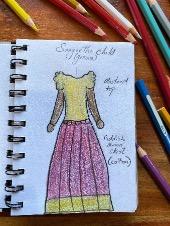





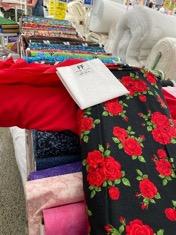




Chinna Penna Pothile
Dingiri Dingale
Eena Meena Deeka
Andru Vanthathum
La Bamba
Pukaratha
Unnidam Mayagukiren
Malarnthum
Anubhavam
Chinna Maamiye
Eternal Flame
Ilaya Nila
Kadhal Oviyam
Kuyile
Yedhedo
Vellai Pura
Chinna Penna Pothile

KARNAN SABA Music Direction
In Tamil culture, songs carry great significance. They are rituals for life’s stages and often hold deep personal significance.
Before and during the 1950’s in Sri Lanka, there were three main music genres.
Songs of the land:
These were songs about the ways people lived. They told tales of celebration, rituals and everyday life.
Devotional Music:
Both the Hindu and Christian communities had a lot of hymns and devotional songs, which often played on the radio.
Film Music:
At that time, independent artists and singers creating and publishing
songs, wasn’t really a thing. Most of the popular music was found in films and was sung by the actors. Films often had 30 to 40 songs in them, and some of them had huge production value.
In the 1950’s, songs from the West started to become popular. They were often "plagiarized" by local artists, who would give them a local flavour by singing in Tamil and using traditional Tamil instruments. With the growing tensions in Sri Lanka, music also started to become a political tool. Baile, which was an afrobeats style imported from Portugal became very popular. People used it to talk about the injustices they faced, to challenge social class and as a tool for political propaganda.

In the 70s, songs in Sri Lanka started to become increasingly politically charged, as people were very angry at the system. But music really took off during the Civil War, as an act of resistance.
For Tamil people all over the world, who have lost a lot, music has become a vehicle for memory. The songs in the show were carefully chosen because they tell another story, about the challenges the characters need to overcome or the context of the play. Each song carries rich subtext for the actors to play with, and were deeply explored during rehearsals.
Exploring design concepts of a mixtape for maladies:
When we are thinking about the design or technological elements of a show, we need to explore how this supports the story being told, heightens atmosphere and tension or creates mood. a mixtape for maladies tells a story of “war, displacement, and cultural identity. Of music’s power to heal and connect and the enduring impact of the past on the present”, therefore, the design and set need to be multi-functional and play an integral part in communicating the narrative. Ahilan Karunaharan created a vivid world for Jane Yonge and the designers to work from. This section will support you to explore the design choices made and what they communicate to the audience. Whether you are doing Level One or Levels Two/Three, you are encouraged to complete the activities in this section.
Close-reading activity: Drama is a rich source of literacy. This activity is based around linking the director and designers’ words to physical examples of design that you saw in the performance as an audience member.
• Split into small groups and choose a scene where the design elements worked in conjunctionespecially sound and lighting.
• Brainstorm all the design elements evident in the scene; use specific drama language and technology terminology.
• Read the interviews and look at the reference images above and do the following:
• Circle ideas that are compelling or interesting that connect to the scene you picked
• Highlight quotes that are relevant to the particular scene you are discussing
• Underline ideas that may not be relevant but you find compelling or punchy
• As a group plan an essay outline for the following prompt using the information that you have gathered using the tools above. Keep it short:
• “How was design used to bring Jane Yonge’s vision to life in a specific moment in the performance?”
• For homework: Using the plan you have constructed as a group, write your own essay in response to the prompt. Share it with a peer from your group and reflect on what you did well and how you could improve your writing.
Exploring the design of the set in a mixtape for maladies:
Referencing Rachel Marlow and Bradley Gledhill’s intentions for the set design, the notes you have already made with the above activity, fill out the chart below. Make comprehensive notes about the set design of a mixtape for maladies.
Set Space Technologies used to create this space
world / The Present Band World The Past
Using the notes that you have compiled above complete the following activity, you could work individually, in pairs or small groups:
• Choose a specific moment from the play that happened in each of the set spaces identified above. You could choose a moment of tension, symbolism or where something important happens to the characters.
• Sketch each of the spaces in comprehensive detail
• Use the notes from the designers to annotate what was technologically happening in that moment; sound, costume, lighting, any special effects, aspects of the set
• Incorporate quotes directly from the designers, for example; ’abstract’ and ’mundane’ lighting, specific musical moments that were symbolic or important to the narrative in that moment
• Incorporate any quotes from the actors that add more detail to this specific moment
• Save your sketches to potentially incorporate into your portfolio or as a revision tool for your exam.


Kiwi-born Deepan is the host of the podcast ’Beat by Beat’ that he hosts from his makeshift studio in his mother’s garage. He has never been to Sri Lanka but hopes to one day. He will hustle at whatever cost to get the story that he wants and when he finds his mother, Sangeetha’s, mixtape he unleashes the past that is beyond what is imaginable.
How do you see your character, what are some of Deepan’s character traits and how do you resonate with him?
“Deepan is an explorer! A young Kiwi-born Sri Lankan, and somebody who hasn’t really connected to his roots growing up. He’s someone who’s open to change and he’s trying hard to forge his own path with his podcast. I resonate with him as a New Zealand born Indian, who hasn’t had as much connection with my heritage, only later in life have I tried to connect with my culturesimilar to Deepan.”

Has the process of working on this show illuminated how you look at your own relationship to culture and heritage?
“It has definitely made me think about my culture more- in the last couple of years, I’ve been connecting with my grandmother and then it’s quite amazing the parallels between sharing stories that are happening inside of my own relationship with my grandmother and Deepan’s relationship with his mother. So it’s been lovely to experience that and then come into this process.”

You’re playing two character over the course of 20 years, what are some tools you use as an actor that help you follow their journey?
“First and foremost all our clues come from the text, so we try and hunt through the text to see what kind of information we can find about these characters at each point in their lives. In terms of implementing that information, trying to show the growth of the characters – that’s where performance tools come in. Things like voice, body language, costume elements and relationship, these all show growth. Also tone of performance – if you are showing us naivety, and innocence we read younger, if you’re showing us groundedness – we read older.”
Anton helps run his father’s supply store and is the village’s top music provider. Whether it’s a temple fair, wedding, or local celebration, Anton provides the perfect soundtrack. His music collection spans generations and genres, reflecting his deep devotion to his country, village, and loved ones.
Has the process of working on this show illuminated how you look at your own relationship to culture and heritage?
“I’m quite lucky in that I’ve grown up quite connected in my culture – I’ve had connections to my indian culture my entire life and it’s interesting working on something that isn’t my exact culture – there are so many similarities across people from different cultural background that it’s quite beautiful to see the shared human experiences. You might eat different food, speak different languages – but everybody knows what it’s like to be heartbroken, to have a family member leave, or to be distant, or to be close to your siblings, these kind of human experiences are shared between cultures and it’s beautiful to be reminded of that.
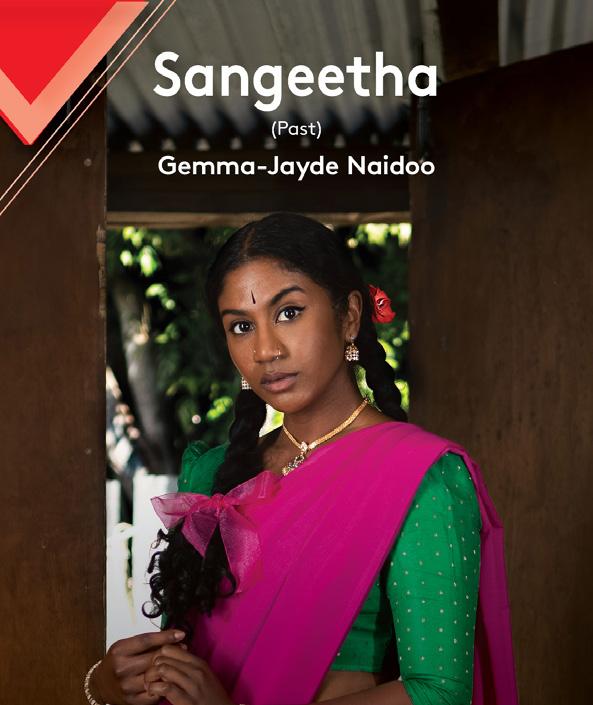
Sangeetha embodies the vibrant chaos of life itself. As the middle child in a family of three, she feels the push-and-pull of her older sister’s responsibility and her younger brother’s carefree nature. Feisty and rebellious, she never shies away from expressing her opinions.
There’s another actor in the show playing Sangeetha but older – what kind of challenges does this come with?
“A challenge I think I’m having is because I’m playing her in the past- trying not to be connected to what Ambika is doing when she’s portraying older Sangeetha because I have none of the backstory that she does – my version of Sangeetha is living it. I can’t play these games, knowing where she ends up at the end of the show – I can’t endgame it. Which is always a struggle in a show, not playing where your character ends up, and playing where they are at any given moment.”
Through the two decades you’re playing Sangeetha, what tools are you using as an actor to follow her journey?
“For me, physicality is a really big thing, in terms of a characters gait, where they hold their weight, how they land informs how they speak, the pace of the character and what their relationships are, and then obviously the circumstances changethinking about how the character would process an event 5 years, 10 years on is kind of a mind game sometimes. Especially sitting in those scenes with the siblings that are super chaotic, and have lots of banter, but we still have the same dynamic, but while it’s the same it’s different when you get older.”
Has the process of working on this show illuminated how you look at your own relationship to culture and heritage?
“Yeah it’s been a beautiful and poignant process- starting with the reading even, almost two years ago. I’m South-African born Tamil Indian and my families lived in South Africa for generations and so we have our own identity, but grew up without the language around me, so it’s been awesome to connect but also learn more about the history of my people that goes beyond South Africa, it was heartwarming but gut-wrenching wondering what would have happened to my family if we never left India. South Africa hasn’t been the friendliest to it’s brown people so I don’t know, maybe if I stayed, things would have been different for them. But seeing this story from Sri Lanka it doesn’t mean anything where you are in the world necessarily, everyone faces this trauma, but I really found myself connecting to my grandma more through the music in this show, because it’s music she grew up listening to!

Sangeetha is a devoted Sri Lankan mother who has poured her heart into raising her son, Deepan. When he questions her with a mixtape that stirs buried emotions, she realises that the vibrant, spirited version of herself she once knew feels lost and unreachable.
You share you character with another actor in the show- is there anything Gemma does that you use as a tool for you character?
“Yes and no, I think I take her energy, her bubbliness and exuberant energy, but I’m also a solid thirty years older as Sangeetha, so at the core we have very similar energies but we’re very different now.”
Has the process of working on this show illuminated how you look at your own relationship to culture and heritage?
“Yeah, it has shifted, what’s shifted for me is – what are the stories I don’t know, should I interrogate my parents a little more about their own stories. I ask myself that a lot, I think similarly, what do I want to pass on to my children, our stories, our whakapapa, our family, our journeys and what have I not told them yet.”
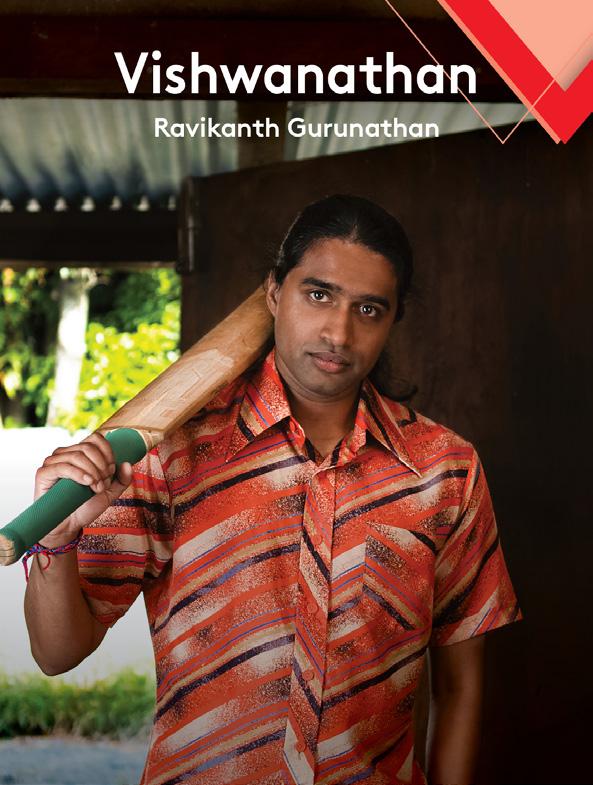
What kind of tools do you use to track a characters journey over two decades?
“What I’m doing right now is, the younger I am the looser my body is, there’s more flop and there’s not as much control and there’s different points of my body I’m leading from. There was a different show (The Life of Galileo) where I had a similar age progression starting from younger and going to even older than I am now, which is harder than playing than younger, because I’ve never been that old – I don’t have that lived experience."
Vishwanathan, or Vishwa, is the family’s soft spot, with an open heart and mind. Music speaks to his emotions, transcending words. Though he seems fragile, Vishwa has a quiet strength, resiliently bouncing back from life’s challenges.
Has the process of working on this show illuminated how you look at your own relationship to culture and heritage?
“Yes and no, whenever I do a show with Ahilan, it always unlocks a real random thing – doing a show where people are speaking your mother tongue- means I have a deeper understanding, and it brings me closer. The no is like, we had a bit of a taster from the reading almost two years ago, and after that I asked my mum lots of questions, and it opened us up to having these conversations.”

What kind of tools do you use to track a character’s journey over two decades?
“I think a lot of it for me as someone who trained as a dancer is finding where she sits in her body at the different ages. That helps me when we’re rehearsing to figure her out. You can do it on a really extreme level when she’s a kid and then slowly that settles into something that’s more naturalistic. That’s a big one for me. There’s vocal techniques as well – how does their maturity affect where the tone of their voice sits?”
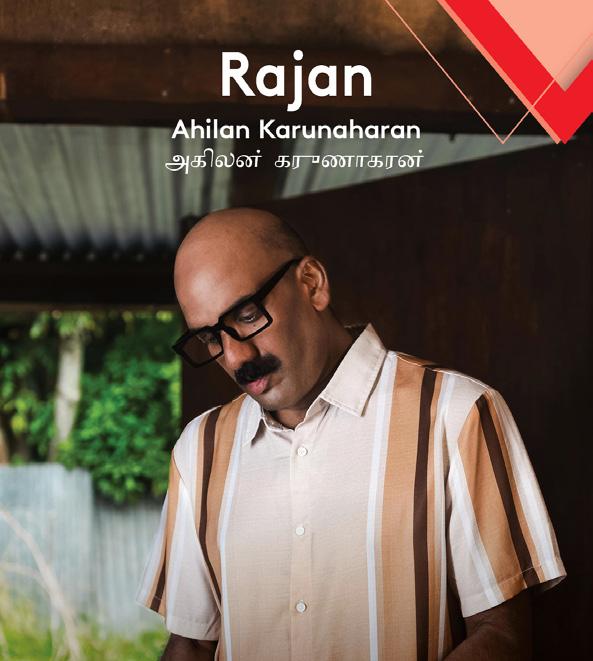
Subbalaxmi, the eldest daughter, carries the weight of her family on her shoulders. Since their mother’s passing, she has taken on the role of nurturer. She finds solace in English and Hindi melodies, often playing soft tracks while doing her daily tasks, allowing the music to express what she cannot.
Has the process of working on this show illuminated how you look at your own relationship to culture and heritage?
“100% I talk about this quite a lot, I was born in New Zealand, I didn’t have a huge connection to Sri Lankan culture, so this was really exciting – the first Sri Lankan play I’ve been able to audition for! It sparked a huge amount of curiosity around that time in Sri Lankan history – I’ve started reading and researching about it. I’m grateful to have had this chance to connect to this part of my heritage.”
Rajan is a single father who finds refuge and expression in music. His political views are shaped by his experiences, and despite his responsibilities, he enjoys simple pleasures to unwind. His love for music and activism influences his parenting, instilling in his children a strong sense of identity and community.
When you are thinking about an actor’s performance to write about in an exam or portfolio setting you will want to build a comprehensive profile of how they used their body, voice, movement and use of space. Details about motivation, ideas or symbols they highlighted and moments of subtext that pointed to themes or relationship dynamics. You will want to link these details to specific moments in the performance, describing what was happening on stage and linking to big ideas and wider context.
These activities will enable you to build a kētē of information about characters you found compelling or who were integral to the narrative.
Each character within a mixtape for maladies has their own narrative arc, relationships and tensions. It is important to understand why the character is behaving the way they are, what has happened for them prior to the play beginning that makes them who they are and what they are communicating to the audience.
• Choose an interview to read
• Circle or highlight ideas that interest you or provide insight
• Get into pairs or small groups and share what you have circled or highlighted and explain why. Make notes or a brainstorm to record your ideas
• Choose a scene that highlights either the character or connects to ideas you have identified. As a group brainstorm how, you might talk about the scene, describing what was physically happening on stage for that character. You could present this to the rest of the class as a: (make sure you save a copy of whatever form you complete this task in)
• Fleshed out brainstorm
• A verbal presentation with written prompts
• A written response
• Acting out a scene and explaining what you are doing.
Literacy Activities:
The following resources are drawn from the NCEA Literacy resources that your teacher will already have access to. While this is a character activity, it will also contribute to literacy skills within this subject. Once the following activities are completed, save a digital copy somewhere where the whole class can access it for revision or portfolio compilation.
Summarising the narrative of a character:
For each character or choose a couple of characters that you found particularly compelling, fill out the summarising narratives chart. Once you have filled it out individually, find someone else in the class who chose the same character as you, share and discuss what you have both written. Add details to your chart that you might have been missing. You could also add quotes from the performance, to enrich this for revision later in the year.
• Summarising (narratives)
Exploring the family:
Create a character relationship map in small groups, if you google that phrase, you will be able to find lots of examples. You could do this by using templates on a programme like Canva or you could do something with pen and paper. Get creative. Your character relationship map should include:
• Name, age, physical appearance of the character
• An important quote that encapsulates the character
• Relationship to other characters in the play, including how they feel about that relationship
• Description of the costume they are wearing and any symbolism
Individual extension activity: For homework use the information you have collected in the above activities to write a short essay or record a voice note responding the following prompt:
Discuss an important character relationship within the production of a mixtape for maladies and how it communicated an important idea or theme to the audience. Incorporate quotes from the actors’ interviews and reference to wider context; social, historical, geographical or political.
Literacy resources sourced from the Drama Literacy Pedagogy Guide written by the Ministry of Education: NCEA Drama Literacy Pedagogy Guide
For further Literacy and Numeracy resources: NCEA Literacy Planning Resources

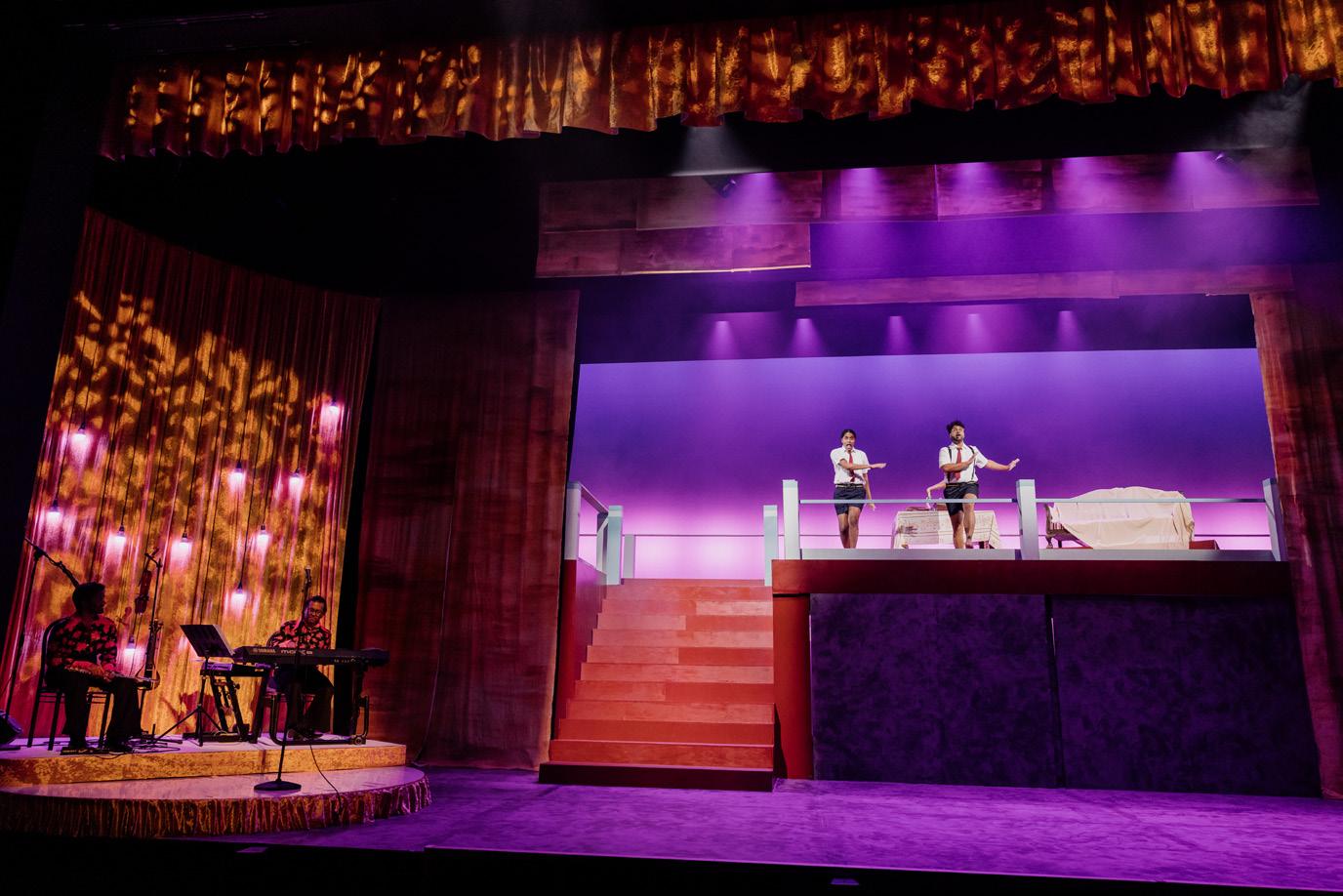
Lyrics:
Haei….yaa…..dingiri dingaalae
Meenaatchi dingiri dingaalae
Ulagam pora pokka paaru thangamae
Haa dingiri dingaalae meenaatchi
Ulagam pora pokka paaru thangamae
Enjoy some background information on some key songs from a mixtape for maladies.
Track : Dingeri Dingale
The year is 1969. Sangeetha, Laxmi and Vishwanathan are waiting for their father, Rajan, to go attend the Temple Fair. They play cricket to pass the time. When Rajan arrives, we learn he was attending a meeting. Rajan hints that things are changing in Sri Lanka… but the kids can only think about having fun at the fair.
The song:
Dingeri Dingale is a Baile song, which, under its playful, fun and dynamic tune, hids a cutting social commentary. The song speaks about
thillaalae meenaatchi dingiri dingaalae thangamae thillaalae
how everything in life changes, except us as humans. We not only refuse to change, but we also refuse to acknowledge when change is inevitably coming. We are too busy competing with each other to realise that community is what matters the most, and this is causing us to lose our humanity.
The song foreshadows the tragic events in Sri Lanka’s history, and illustrates Rajan (and the children’s) desire to keep living daily life as if nothing bad is happening. They are keeping their heads in the sand for now, but times are quickly changing.
Hey… yaa… Dingiri Dingalae
Oh, Meenakshi, Dingiri Dingalae!
Watch how the world moves, my golden one, swaying in its rhythm.
Oh, Dingiri Dingalae, Meenakshi, Dingiri Dingalae!
See the world’s journey unfold, my precious, dancing through time.
Track: Malarnthum
The year is 1976. Laxmi and Vishwanathan are chatting at home, suspecting Sangeetha of having gone off to flirt with Anton, her love interest. There are guests downstairs with their father, Rajan. Laxmi and Vishwanathan soon realise that this is not an informal visit- it is a marriage proposal for Laxmi.
The Song:
Malarnthum is a song about a brother and a sister, and how far they will go to protect each other and their family. It represents Laxmi’s coming of age, as she is about to get engaged, as well as Vishwanathan’s inability to speak openly about his own relationship.
Malarnthum is a song from a famous Indian movie, which most Sri Lankans of that generation will have watched. For those who have seen the film, the song also serves as a prediction for what is about to happen. It foreshadows the difficult choices the siblings will have to make. In the original film, both the brother and sister tragically die – will Laxmi and Vishwanathan suffer the same fate?
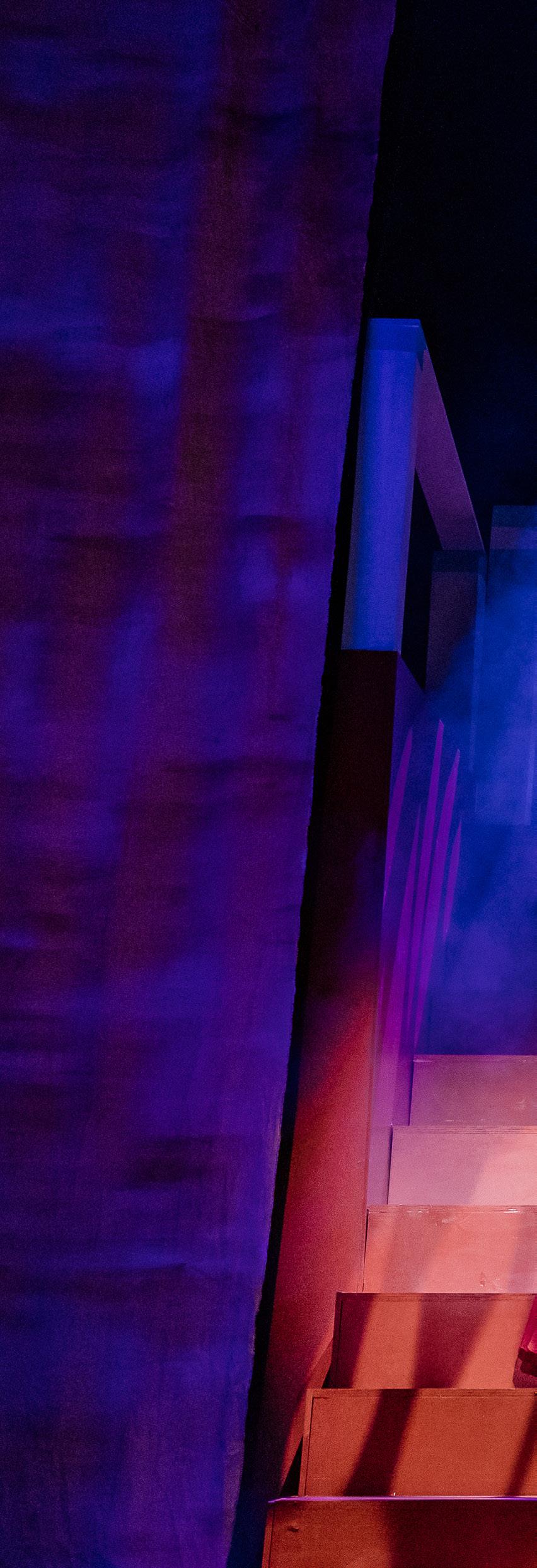
Lyrics:
Malarndhu malaraadha
Paadhi malar polae
Valarum vizhi vannamae
Vandhu vidindhum
Vidiyaatha kaalai pozhuthaaga
Vilaindha kalai annamae
Nadhiyil vilaiyaadi
Kodiyil thalai seevi
Nadantha ilam thendrale
Valar podhigai
Malai thondri madurai
Nagar kandu pozhindha

A blossom that never fully blooms, Like a half-bloomed flower, Your eyes grow in hues of wonder.
Even as the dawn arrives, It never feels like morning, Like an artful swan born at twilight.
Dancing upon the river’s waves, Resting its head upon the vines, The wandering young breeze.
Growing in the shade of Podhigai hills, Where Madurai’s splendour unfolds, And time gently flows away.
Track : Vellai Pura
The year is 1986. Sangeetha and Vishwanathan spending their final moments in their family home, where Vishwanathan pleads with Sangeetha to leave. It is too dangerous to stay put. Sangeetha eventually agrees to escape first, but makes Vishwanathan promise he will join her soon. This will be the last time she sees him.
The Song:
Vellai Pura is a song about a white dove, a symbol of peace that is gone. For a very long time, the only thing Sri Lankan Tamils wanted was acknowledgement from their country. Till this day, many people aren’t aware of what happened in Sri Lanka, and the country and its population is still healing. The track speaks about the absence of the dove, the unpredictability of fate and the fact that we don’t know what the future holds. But there is still hope in the song: no matter how hard things get, life goes on. This time will pass, and we must keep moving forward.

Vellai pura ondru
Ponadhu kaiyil varamalae
Vellai pura ondru
Ponadhu kaiyil varamalae
Male : Mudhal ezhuthu
Thai mozhiyil
Thalai ezhuthu
Yaar mozhiyil
En vazhkai vaan veliyil
Oh oh oh….
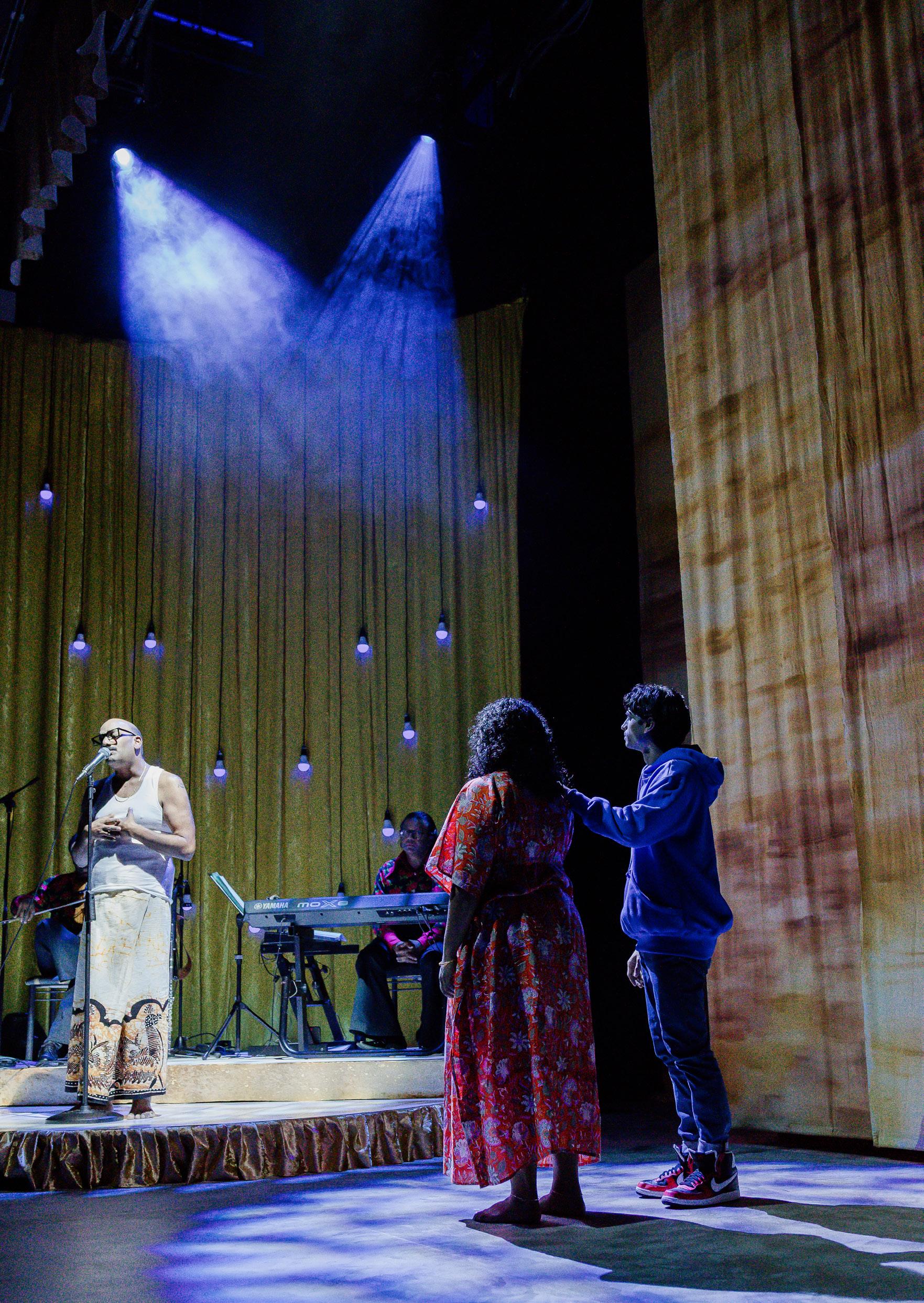
A white dove took flight, Yet never found its way to my hands. A white dove soared away, Yet never came to rest in my grasp.
The first letter, Written in my mother tongue, But whose script Marks my destiny’s sky?
Oh, oh, oh...
Music plays a powerful role in a mixtape for maladies, connecting characters narratives and evoking memory. You will have discussed music as part of the design section of this pack. The first activity encourages you to discuss the music that was used in the production and how it links to the historical context. The second two activities are a bit of fun and could be used if you were devising or exploring different ways of working in class.
Group activity: Choose one music style or song from the performance that you found compelling. Answer the following questions together (you could voice record your answer):
• What do you like about this music in this moment of the performance?
• What does it make you feel?
• What does it make you think about?
• How does it connect to a theme, idea, moment in history or character in the play?
Exploring the music styles of a mixtape for maladies
Referencing the information about the music included in this pack; such as the lyrics, scene placement, historical or social links and discuss how it impacts the narrative being communicated to the audience. Complete some or all the following activities:
In pairs: Discuss the music referenced; make notes or sketch your thoughts and ideas about the narrative the songs communicate or what themes, ideas or symbols arise as you watched the performance.
• Create a Spider Diagram that links that music to technical choices, moments in the play that made you think, characters, quotes, directing choices and historical, social and political references.
Individual homework activity: From this Spider Diagram think about the following prompt and respond with a short essay OR a voice note:
How does the music seek or heal and connect in a mixtape for maladies?
Create your own playlist
Music plays a powerful role in evoking emotion or memory. Think about the way you can remember song lyrics years later or how a song
evokes a specific feeling or memory when you hear it.
Thinking about the structure of a mixtape for maladies use the following instructions to devise a short scene that is based on a strong memory:
• Share a song and a memory with your group. Note down all your memories and simplify them to a short moment
• Devise a short scene that incorporates all your memories
• Ensure the structure of your scene is influenced by a mixtape for maladies structure
• Create a Spotify/YouTube/Song playlist of the songs connected to your memory and use the music in your performance in a creative way – you may need to assign a tech person for this performance
• Perform your scene for your peers and discuss/reflect on the following:
• The power of sharing our own stories
• How the music impacted the audience, what it made them think and feel
• How effective the structure was
• How you could extend the scene if given time
Create a reel with music that evokes powerful memories
As a fun exercise at home ask your parents/caregivers if you can look through photos of their past, childhood, teen years, important moments in their life.
• Use a scanning app on your device or phone to digitise these photos if they aren’t already
• Discuss a song that evokes a powerful memory for your parent/ caregiver
• Create a reel that captures the memories
• Share with your parent/caregiver and discuss how the music impacts the memories
• If you feel comfortable share with your classmates and teacher
Titiro whakamuri, kōkiri whakamua – Drama is influenced by whakapapa and is a way to respond to and share identity, culture, and perspectives
An aspect of the significant learning done at Level One of NCEA is to “contribute to theatre Aotearoa and understand that drama is a way to explore and reflect on whakapapa.” You may be doing this through exploring plays written by Aotearoa playwrights in class, performing scenes from those plays, discussing the function of each play and how they connect with an audience. Whether you are a Year 11 student or in a younger or older year level, this section of the pack aims to extend your understanding of theatre and its function. It will also prompt you to think about how what you see at the theatre can connect with work you are doing in class.
Activity: As a class brainstorm all the ways that this play reflects Aotearoa and speaks to a local audience. Include the following examples in your brainstorm:
Language or quotes that feel specific to Aotearoa
• Te Ao Māori/mātauranga Māori
(Māori knowledge) elements or references
• Accents, acting style
• Specific design choices that reflected our place in the world
• Key scenes or viewpoints represented that reflected Aotearoa
• In the case of a mixtape for maladies, how does this play reflect the experience of tauiwi or people who have immigrated, in Aotearoa?
Take a photo of this brainstorm and keep it in a shared digital space so you can reference it throughout the other activities in this pack.
Function in this section refers to: the plays ability to heal, educate, entertain or transform an audience.
In small groups or in pairs, brainstorm, research and record responses to the following questions. (A mode of recording has been suggested for each question to enrich your literacy skills):
The function of a mixtape for maladies: Brainstorm with pen and paper. Ensure you explore and debate the four words encompassed in the definition of function and then construct a written response that
focuses on a specific scene.
• What ideas, themes or messages are being communicated to the audience?
• What impact is that having on the audience?
• How are these ideas healing, educating, entertaining or transforming the audience?
• Can you connect this to a specific scene or moment from the performance?
• What have you thought about since?
You could use the following resource to support you: Purpose and Audience Analysis
Connection with the audience: Record a verbal discussion where you talk about the following questions. You could brainstorm the questions first, but it is important you don’t script your response.
• Who do you think the intended audience is and why? Who do you think Ahilan Karunaharan wrote this for and why?
• What influence has Jane Yonge had on the realisation of the play on stage? How do you think this connects with the audience?
• What draws you into the story? The actors, the design, the writing, the themes and ideas? Discuss why.
• What were you feeling throughout the performance?
Communicating function through drama techniques: these activities are based around developing the skill of sketching and annotation. You can cover one, some or all of the activities.
• Characters connection to a mixtape for maladies: Look at the characters represented in the play and explore their connection to the thematic content of the performance. Use these questions and the information in the front of this pack to guide you. Create a diagram that represents each character’s arc, and explore why this is important when discussing the plays themes, ideas and wider context. You could choose a couple of scenes to focus on.
• What do you know about the characters - ethnicity, where they are from, their whānau, their upbringing - how does this influence the way they view the world?
• What are their dreams and aspirations?
• What is motivating or driving them? Why do you think they behave the way they do?
• What are key quotes that capture the personality, beliefs and aspirations of the characters?
• What are their relationships like and what does this say about the way they act on the issues and themes evident in the play?
• Role on the Wall: Choose a character you found compelling or impactful. In a Role on the Wall explore how the actor used techniques to support the function of the play. Narrow this down to a single moment.
Role on the Wall instructions:
• Draw the outline of your character - could be a gingerbread man shape, stick figure, etc.
• On the outside you will note the external drama techniques you see the actor using in a specific moment, that communicate the function. Use of body, voice, movement and space
• On the inside you will think about or imagine what might be driving these choices; emotions, motivations, subtext.
a moment in the performance that communicated the function. Create an extensive mind map which details how that element was brought to life through the script, the characters, directorial and design choices.
• For example; what does setting the performance in both Aotearoa New Zealand and Sri Lanka communicate to the audience?
• Storyboarding: Choose a moment where a specific drama convention highlights the function. Map out on a short storyboard with captions, how the convention was used, detailing what you saw on stage and what it communicated to the audience.
• Sketching and annotating: Choose a moment where technology was used to highlight the function. Sketch how this looked on stage and annotate comprehensively.
• Mind mapping: Looking at the drama elements, choose one that you felt was highlighted in
Bringing ideas to life through play: these ideas could contribute towards or become provocations/stimulus for devised drama.
• Choose a line from a mixtape for maladies that you found compelling or impactful. Discuss why as a group.
• Break down the line, think about what it means and
what it represents in the play, how it might heal, educate, entertain or transform. What does it make you think about and feel? Does it call you to action?
• Develop a short scene that explores what you have discussed using conventions and elements.
• Prior to performance explain how your short scene connects to the line you have chosen and how it heals, educates, entertains or transforms.
• Make sure that you choose conventions and elements that will communicate your ideas in a coherent way.
• Choose a moment in the performance where you could add more information about a character or an event. This could be prior to the play beginning, during the narrative or what happened next.
• Develop a short scene using conventions and elements
• Discuss together how this scene extends on ideas in the play
• Prior to performance explain how your short scene heals, educates, entertains or transforms the audience. Discuss how you have used conventions and elements to communicate this.
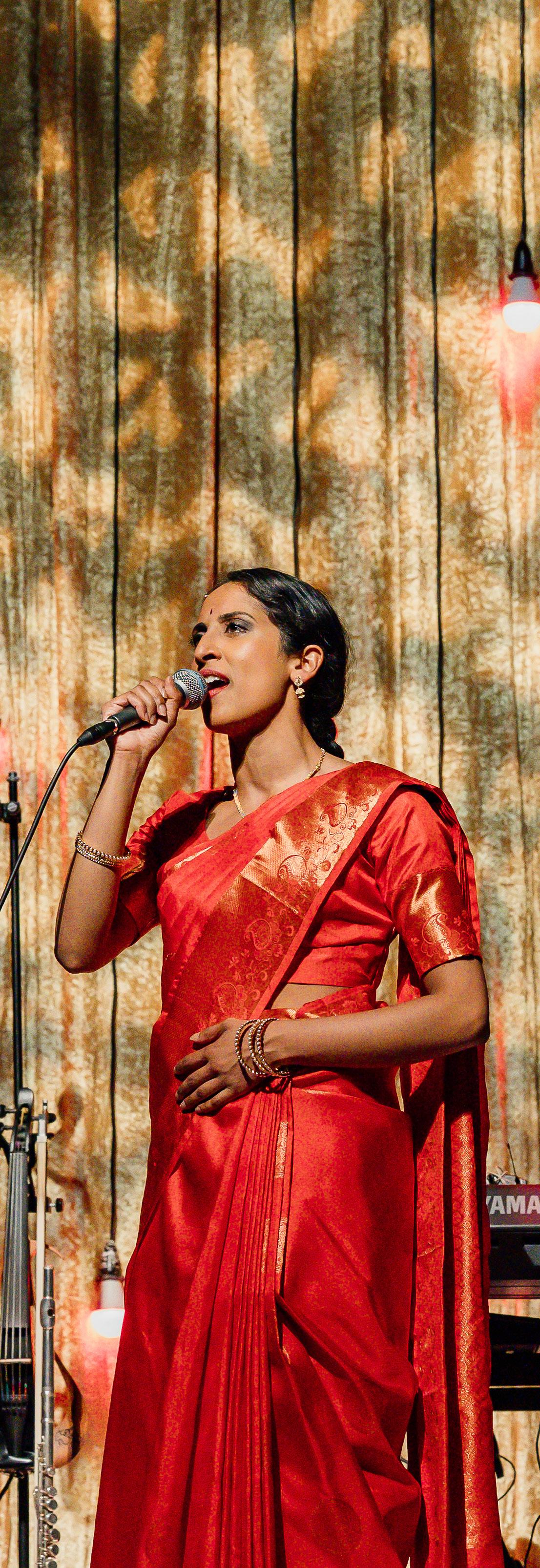
Drama | NCEA
Explore the function of theatre Aotearoa | NCEA
“Drama transforms the tangible into the intangible.”
This section of the education pack is designed to support Level One drama students navigate the new Level One external Achievement Standard 91943 - Respond to a drama performance. Unlike the Level Two and Three external standards, which are an exam, you will be constructing a portfolio, over a period of time in class and it will be based around three key aspects;
• key message of the performance
• the use of drama components
• your own personal response about how you connected to the performance, capturing the wairua (spirit) of what you watched.
This portfolio will be presented as a slideshow or PowerPoint and can be a mixture of written and audiovisual material - the main question you should ask yourself as a student is; how do I communicate my ideas, thoughts, and feelings about what I saw, the best? With that in mind, you are encouraged to collect your thoughts, discussions and do your research in a range of formats. Such as voice notes, sketches and annotations, brainstorms, mood boards, recorded physical responses and writing.
Kaiako/Teachers and ākonga/ students please ensure you read this year’s assessment specifications carefully as you prepare to submit this assessment. You can access the specifications via this link: NZQA Assessment Specifications - Level One
Below are three activities to support you to expand your ideas and support you during the teaching and learning phase of unpacking the performance.
In pairs, small groups or as a whole class, discuss and brainstorm the following prompts:
• What do you think Ahilan Karunaharan was trying to say? Why this story? Why these characters? Why this period of time?
• What do you think Jane Yonge was trying to communicate through the choices she made? How does this connect with what the Karunaharan has written?
• What do the characters in the performance represent and what do they communicate to the audience?
• What do you think the designers are trying to communicate through their choices? How does this bring the playwright’s ideas to life?
Once you have brainstormed around these questions, you could journal, voice note or record thoughts around the following questions:
• How do you identify the key message of a performance?
• Can there be multiple key messages?
• Think about your interpretation of the performance - what was the key message to you?
• What physical evidence from the performance connects to the key message? This could be a scene, a moment between characters, dialogue, a moment where the use of technology highlighted an idea.
• Describe these examples and sketch them in specific detail.
Drama components are techniques, elements, conventions and technologies. Make sure you have explored this language and terminology with your kaiako/ teacher.
Now that you have fleshed out what the key message might be, you need to connect it with the choices that the director, designer and actors have made and how they have used the drama components in combination.
Brainstorm in small groups, or in pairs:
• How an actor used drama techniques in a moment that communicated the key message
• How elements created a sense of mood, atmosphere or tension
• How conventions were used throughout the performance
• How technology enhanced the story being told
In the unpacking on the NCEA website for this standard, this aspect of the assessment is unpacked in detail. Your teacher will support you in understanding this and guide you to explore, research and develop your ideas.
“The wairua of the performance is experienced as the intangible energetic and emotive qualities that carry the spirit and intention of the play. How the wairua is expressed by the performers provokes a response from the audience and allows them to reflect on the ideas and themes of the play based on their own life experiences and perspectives.”
- 1.4 - Unpacking
• What thoughts, ideas and feelings did the performers provoke in you?
• What have you reflected upon since watching the performance?
• What have you been thinking about (head) and feeling (heart) since?
• What did your gut/sense of intuition communicate to you as you watched the performance?
• What life experiences or perspectives do you bring? What connections did you make?
Drama | NCEA
Level One External Specifications
If you are a Year 12 and 13 student who attended the production of a mixtape for maladies you will likely have had your Live Performance exam in mind as you watched the performance. You are encouraged to look at the questions written for Year 11/Level One students in the previous section and the activities throughout the pack, especially references to Theatre Aotearoa. Having discussions around theatre’s ability to heal, educate, entertain and/ or transform can deepen or widen your point of view. With this in mind, the questions below will support you to revise for your exam at the end of the year but will also enrich your thoughts, feelings and ideas
about the performance of a mixtape for maladies and may expand your own work that you develop in the classroom. You are encouraged to explore the questions both individually and with your peers.
Note: When answering the following question, you will want to find and provide physical examples from the production. A physical example is when you describe, with specificity, what is happening on stage at the time. Get down to specific detail, for example, explaining how the actor/ performer is standing or moving, how far away from the audience they are, what is happening with technology, where exactly they are in space, etc. The more detail, the better!
• Describe how an actor who you found interesting or compelling used drama techniques in a specific moment in the performance.
• Add details about why you found this character compelling.
• Describe how two actors used proximity during a moment of tension.
• Discuss how a character created focus in a specific moment within the performance.
• Discuss how a character established a sense of time and/or place through their use of techniques.
• Discuss how an actor uses drama techniques during a solo moment on stage. What were they aiming to communicate? What did you understand at that moment?
• Explain how two actor’s use drama techniques to establish their relationship within the performance. Choose specific moments where you felt the actors used their body, voice, movement, and space in combination to:
• Create impact, focus, or to support an important idea about that relationship.
• Create a sense of time and place?
• Communicate their history?
• Create a sense of mood or atmosphere in a specific moment?
• How did an actor use drama techniques to communicate subtext in their performance? Use a specific moment and example to discuss this use of subtext.
• Describe a moment where a character used movement or body language that was symbolic.
• Discuss what the character communicated to the audience; how did the actor portray them? Plot their character arc and describe how he uses techniques to communicate this.
• Discuss the purpose of the characters:
• What impact do they have on the narrative, as well as the audience and actors’ relationship?
• How does the actor’s use of techniques communicate their purpose in the performance?
• Explore the ensemble of characters as a whole: what purpose do they serve in the narrative?
• Discuss the relationship between the characters of the present and the characters of the past.
• How did you connect with these characters?
• What have you been thinking about since?
• Discuss how technology or design was used during a climatic moment in the performance? What do you think was at stake within the scene?
• Discuss the purpose of the performance and how the themes or ideas link to what is happening in the world; socially, politically or historically. Link your ideas to specific moments or examples from the performance.
• How did the way the performance was realised impact the style of delivery of the narrative/story?
• How does the content of the play challenge and serve the audience?
• Discuss how Jane Yonge brought the story to life using Drama Components - Elements, Conventions, Techniques and Technologies.
• What do you think Yonge is asking you to think about in the way she has directed a mixtape for maladies?
• How did the acting and staging choices affect you as an audience member?
• How was music woven into the way the play was performed?
• Why were the songs important? What did they teach you about the world of the play?
• How did the music heighten tension OR create mood/ atmosphere?
• What did the music symbolise within the world of the play?
• Discuss how the music connected to the wider historical context of the performance.
• How was Sri Lankan culture woven into the design elements of the performance?
• How did the set design delineate between the past and the present?
• How did the set design establish a sense of place and time?
• What was the impact of the way the design, directorial, and acting choices worked together? Choose a moment that surprised, shocked, or excited you to talk about.
• Discuss why the use of sound and lighting design was integral to this performance? Focus on the mood created by sound choices, use of colour and the shapes created by the angles or composition of lighting.
(NB - make sure you are familiar with what the established Drama Conventions are by discussing this with your teacher)
• Identify a moment in the performance where Drama Conventions were used to create focus, mood or atmosphere:
• Explain how the convention or combination of conventions were used in the performance
• Discuss the impact of the use of the convention or combination of conventions in this moment
• Discuss how meaning was created for you, as an audience member, in this moment
• Discuss how the use of a convention or combination of conventions in a specific moment
helped you think about the big ideas and themes of the play.
• What was the wider context (socially, historically, politically or geographically) that this moment linked to?
(ROLE, TIME, PLACE, SITUATION, ACTION, TENSION, FOCUS, MOOD, SYMBOL)
• What were the main themes, questions and ideas evident in the performance? Link these themes, questions and ideas to specific moments or examples from the performance.
• How were design and directorial elements (props, setting, AV, costuming, audience positioning and interaction) and the Drama Elements used to build the performance? How did this make you feel as a member of the audience?
• Identify recurring symbols or motifs throughout the performance. Explain why they were important in helping you understand ideas being communicated in a mixtape for maladies?
• How do these themes, symbols or ideas link to the wider world of the play and what impact does this have on the audience?
• Were there moments where the content was confronting or forced you to think about something in a new light? What impact does this have on the audience and you as a member of the audience?
• Reference the Ahi Karunaharan’s intention as a playwright and think about what he was communicating through the lives and arcs of the characters in the play.
LINK YOUR IDEAS TO SPECIFIC MOMENTS OR EXAMPLES IN THE PERFORMANCE.
Think about lighting, set, sound, props, costumes, make-up and how this helped bring you into the world of the play.
• How was technology used to create the atmosphere in the performance?
• How was technology used to highlight important ideas, themes and symbols in the performance?
• How was contrast and/or focus created or built through technology and why was this important?
• How did the use of technology help you gain a deeper understanding of the themes of a mixtape for maladies?
• How did technology highlight the different viewpoints/stories the characters expressed within the performance?
• Discuss why this was impactful, exciting or challenged your expectations.
• How were costumes used to communicate the characters’ purpose in the performance?
• Sketch and annotate the three spaces that the designers built for the world of a mixtape for maladies.
When you are writing about Set or Costume, you need to be specific about the following details and also sketch what you see. Imagine the person you are writing for has not seen the production and create a vivid image in their mind of what you saw:
• For example: Set/Props
• The size, shape and dimensions of any set pieces or props used
• The materials used, their textures and the colours